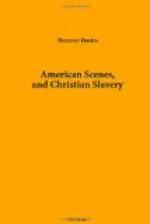In addition to the regular college course of four years, those who study for the ministry go through a theological course, which occupies three years more. No charges are made for tuition or lectures. For the accommodation of students of this order a building has been erected, in which the rooms are free of charge. The law department, in like manner, occupies two years, and the medical two or three.
Let us now go and see the graves of the Regicides. They are at the rear of the Centre Church. Soon after the restoration of Charles II., many of the judges who had condemned to death his father were apprehended; of whom thirty were condemned, and ten executed as traitors. Three, however, made their escape to New England,—Generals Goffe and Whalley, and Colonel Dixwell. A cave is shown in the neighbourhood, still called the “Judges’ Cave,” in which a great part of their time was spent in concealment. Many were their hair-breadth ’scapes from their pursuers—the Royalist party. The colonists, however, gave them all the sympathy and protection that they deserved. On one occasion, knowing that the pursuers were coming to New Haven, the Rev. Mr. Davenport preached on the text, “Hide the outcasts; betray not him that wandereth. Let mine outcasts dwell with thee, Moab; be thou a covert to them from the face of the spoiler.” This, doubtless, had its effect, putting the whole town on their guard, and uniting the people in caution and concealment.
Do you see that rudely-shaped, dark blue stone, about 2 feet in width, the same in height, and 8 inches thick? Do you see the inscription upon it—E W in coarsely-carved letters, and the figures 1658 over them? That is, doubtless, the headstone of Whalley’s grave. The footstone is similar, having the same letters; but above them you see figures that may be read either sixteen hundred and fifty-eight, or sixteen hundred and seventy-eight—16578. The latter was the date of the General’s death; and the figures, perhaps, were thus tampered with to baffle the Royalists.
The other stone, about a foot broad and ten inches high, bearing the letters M. G. and the number 80, is supposed to indicate the resting-place of Goffe. He died about the year 1680. The M, with a deep-drawn stroke under its limbs, may be taken for an inverted W; and thus, with the G, stand for William Goffe, in harmony with the designed concealment that pervades the whole. Colonel John Dixwell lived here, for seventeen years or more, under the assumed name of James Davids, and died here after an exile of twenty-nine years from his native country. He, as well as the other two judges, lived and died in the firm expectation of another revolution in England. That revolution had actually taken place in the November before his death; but, as those were the days of slow and tedious voyages, the news did not arrive till about a month after his death. A little before his decease he revealed to the people his real name and character, which had long been known to the Rev. Mr. Pierpont the minister, but requested that no monument should be erected at his grave, “lest his enemies might dishonour his ashes,” but only a plain stone inscribed with his initials J. D., Esq., his age, and time of death. And here it is—that piece of red stone, about 2 feet in height and breadth, and 5 inches thick, inscribed—




